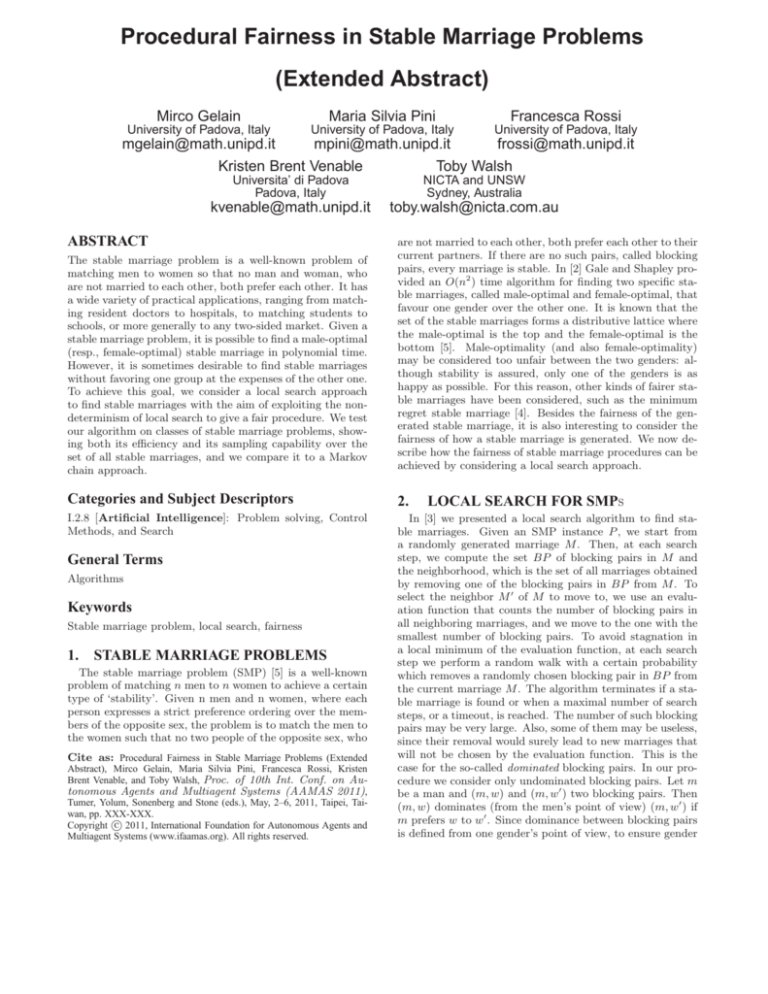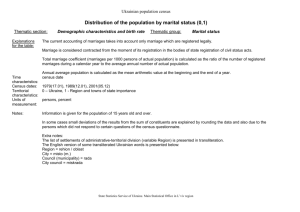
Procedural Fairness in Stable Marriage Problems
(Extended Abstract)
Mirco Gelain
Maria Silvia Pini
Francesca Rossi
University of Padova, Italy
University of Padova, Italy
University of Padova, Italy
mgelain@math.unipd.it
mpini@math.unipd.it
frossi@math.unipd.it
Toby Walsh
Kristen Brent Venable
Universita’ di Padova
Padova, Italy
NICTA and UNSW
Sydney, Australia
kvenable@math.unipd.it
toby.walsh@nicta.com.au
ABSTRACT
The stable marriage problem is a well-known problem of
matching men to women so that no man and woman, who
are not married to each other, both prefer each other. It has
a wide variety of practical applications, ranging from matching resident doctors to hospitals, to matching students to
schools, or more generally to any two-sided market. Given a
stable marriage problem, it is possible to find a male-optimal
(resp., female-optimal) stable marriage in polynomial time.
However, it is sometimes desirable to find stable marriages
without favoring one group at the expenses of the other one.
To achieve this goal, we consider a local search approach
to find stable marriages with the aim of exploiting the nondeterminism of local search to give a fair procedure. We test
our algorithm on classes of stable marriage problems, showing both its efficiency and its sampling capability over the
set of all stable marriages, and we compare it to a Markov
chain approach.
are not married to each other, both prefer each other to their
current partners. If there are no such pairs, called blocking
pairs, every marriage is stable. In [2] Gale and Shapley provided an O(n2 ) time algorithm for finding two specific stable marriages, called male-optimal and female-optimal, that
favour one gender over the other one. It is known that the
set of the stable marriages forms a distributive lattice where
the male-optimal is the top and the female-optimal is the
bottom [5]. Male-optimality (and also female-optimality)
may be considered too unfair between the two genders: although stability is assured, only one of the genders is as
happy as possible. For this reason, other kinds of fairer stable marriages have been considered, such as the minimum
regret stable marriage [4]. Besides the fairness of the generated stable marriage, it is also interesting to consider the
fairness of how a stable marriage is generated. We now describe how the fairness of stable marriage procedures can be
achieved by considering a local search approach.
Categories and Subject Descriptors
2.
I.2.8 [Artificial Intelligence]: Problem solving, Control
Methods, and Search
In [3] we presented a local search algorithm to find stable marriages. Given an SMP instance P , we start from
a randomly generated marriage M . Then, at each search
step, we compute the set BP of blocking pairs in M and
the neighborhood, which is the set of all marriages obtained
by removing one of the blocking pairs in BP from M . To
select the neighbor M ′ of M to move to, we use an evaluation function that counts the number of blocking pairs in
all neighboring marriages, and we move to the one with the
smallest number of blocking pairs. To avoid stagnation in
a local minimum of the evaluation function, at each search
step we perform a random walk with a certain probability
which removes a randomly chosen blocking pair in BP from
the current marriage M . The algorithm terminates if a stable marriage is found or when a maximal number of search
steps, or a timeout, is reached. The number of such blocking
pairs may be very large. Also, some of them may be useless,
since their removal would surely lead to new marriages that
will not be chosen by the evaluation function. This is the
case for the so-called dominated blocking pairs. In our procedure we consider only undominated blocking pairs. Let m
be a man and (m, w) and (m, w′ ) two blocking pairs. Then
(m, w) dominates (from the men’s point of view) (m, w′ ) if
m prefers w to w′ . Since dominance between blocking pairs
is defined from one gender’s point of view, to ensure gender
General Terms
Algorithms
Keywords
Stable marriage problem, local search, fairness
1.
STABLE MARRIAGE PROBLEMS
The stable marriage problem (SMP) [5] is a well-known
problem of matching n men to n women to achieve a certain
type of ‘stability’. Given n men and n women, where each
person expresses a strict preference ordering over the members of the opposite sex, the problem is to match the men to
the women such that no two people of the opposite sex, who
Cite as: Procedural Fairness in Stable Marriage Problems (Extended
Abstract), Mirco Gelain, Maria Silvia Pini, Francesca Rossi, Kristen
Brent Venable, and Toby Walsh, Proc. of 10th Int. Conf. on Autonomous Agents and Multiagent Systems (AAMAS 2011),
Tumer, Yolum, Sonenberg and Stone (eds.), May, 2–6, 2011, Taipei, Taiwan, pp. XXX-XXX.
c 2011, International Foundation for Autonomous Agents and
Copyright Multiagent Systems (www.ifaamas.org). All rights reserved.
LOCAL SEARCH FOR SMPS
1
0.9
average normalized distance
average normalized entropy
1
0.9
0.8
0.7
0.6
0.5
n=10
n=20
n=30
n=40
n=50
n=60
n=70
n=80
n=90
n=100
0.4
0.3
0.2
0.1
0
20
40
60
80
100 120
steps
140
160
n=10
n=20
n=30
n=40
n=50
n=60
n=70
n=80
n=90
1
n=100
0.8
0.8
0.7
0.7
0.6
0.6
0.5
0.5
0.4
0.4
0.3
0.3
0.2
0.2
0.1
0.1
0
180
200
SML2 En
SML2 Dm
MC En
MC Dm
0.9
0
20
40
60
80
(a)
100 120
steps
140
160
180
200
10
(b)
20
30
40
50
60
problem’s size
70
80
90
100
(c)
Figure 1: Average runtime entropy of MC (a), average runtime distance from the male-optimal of MC (b),
Local Search vs. MC in terms of entropy and distance from the male-optimal (c).
neutrality, at each search step we swap the role of the two
genders.
3.
MEASURING PROCEDURAL FAIRNESS
Probability to find a stable marriage
We ran experiments on randomly generated SMPs of different size, up to 500 men and 500 women, with random
walk probability 0.2. Our algorithm always found a stable
marriage. Also, its runtime behavior suggests that the number of steps grows as little as O(nlogn) [3]. Here we show
that the algorithm is able to find a stable marriage for all
the problems in the test set within 10000 steps, and for each
set of problems of the same size, the probability to find a
stable marriage grows very fast within a small interval of
steps (see the figure below). This means that it is possible
to predict the number of steps needed by our algorithm to
find a stable marriage with a reasonable precision.
n=100
n=200
n=300
n=400
n=500
0.9
0.8
0.7
0.6
0.5
0.4
0.3
0.2
0.1
0
1
10
100
1000
10000
steps
In [3] we evaluated the sampling capability over the lattice
of stable marriages of a given SMP. To do this, we randomly
generated 100 SMP instances for each size between 10 and
100, with step 10. We then measured the distance Dm of the
found stable marriages (on average) from the male-optimal
marriage. If Dm is equal to 0 (resp., 1), it means that all the
stable marriages returned coincide with the male-optimal
(resp., female-optimal) marriage. The average distance from
the male-optimal is around 0.5 as shown in Fig. 1(c), where
our algorithm is called SML2. This is encouraging but not
very informative, since also an algorithm which always returns the same stable marriage, with distance 0.5 from the
male-optimal, would have Dm = 0.5. To have more informative results on the sampling capabilities, we considered the
entropy of our algorithm, say En , that is, the uncertainty to
find a specific stable marriage. More precisely, En is the average normalized frequency of the stable marriages returned
by our algorithm over the whole lattice (see [3] for the formal
definition). Experimental results showed that this entropy is
in general very high (about 70% of the maximum and even
higher as shown in Fig. 1(c)) and thus we are not far from
the ideal behavior.
To better evaluate the sampling capability of our approach,
here we compare it to a Markov chain approach (MC) [1],
defined by using rotations exposed in each stable marriage.
This approach converges in exponential time to the uniform
distribution over the stable marriages. We consider the entropy and distance from the male-optimal of MC computed
on executions where we vary the number of steps from 10
to 200. While the entropy of MC increases quite rapidly,
the distance from the top of the lattice (i.e., from the maleoptimal) increases more slowly (see Fig. 1(a) and Fig. 1(b)).
For each problem instance in the test set, we start MC from
the male-optimal marriage and take the stable marriage returned by MC after exactly the same number of steps needed
by our algorithm to find a stable marriage for that instance.
Then we measure and compare the entropy and the distance
from the male-optimal for MC to those of our algorithm
(SML2). While the entropy of MC is roughly the same as
that of our algorithm, the distance from the male-optimal
achieved by our approach (about 0.5) is on average higher
that that achieved by MC (about 0.2) (see Fig. 1(c)).
Summarizing, our approach is efficient and it has sampling
capabilities comparable with a Markov chain approach considering the same number of steps, and may even perform
slightly better considering the distance measured from the
top or the bottom of the lattice.
4. REFERENCES
[1] N. Bhatnagar, S. Greenberg, and D. Randall. Sampling
stable marriages: why spouse-swapping won’t work. In
SODA, pages 1223–1232, 2008.
[2] D. Gale and L. S. Shapley. College admissions and the
stability of marriage. The American Mathematical
Monthly, 69(1):9–15, 1962.
[3] M. Gelain, M. S. Pini, F. Rossi, K. B. Venable, and
T. Walsh. Local search algorithms on the stable
marriage problem: Experimental studies. In ECAI’10,
pages 1085–1086, 2010.
[4] D. Gusfield. Three fast algorithms for four problems in
stable marriage. SIAM J. Comput., 16(1), 1987.
[5] D. Gusfield and R. W. Irving. The Stable Marriage
Problem: Structure and Algorithms. MIT Press,
Boston, MA, 1989.







